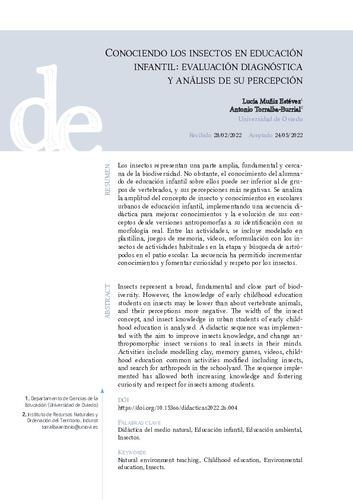Conociendo los insectos en educación infantil: evaluación diagnóstica y análisis de su percepción
Autor(es) y otros:
Palabra(s) clave:
Educación Ambiental
Educación Infantil
Insectos
Didáctica del Medio Natural
Biodiversidad
Biodiversidad urbana
Environmental Education
Childhood Education
Insects
Biodiversity
Urban biodiversity
Fecha de publicación:
Editorial:
Universidad Autónoma de Madrid
Versión del editor:
Citación:
Descripción física:
Resumen:
Los insectos representan una parte amplia, fundamental y cercana de la biodiversidad. No obstante, el conocimiento del alumnado de educación infantil sobre ellos puede ser inferior al de grupos de vertebrados, y sus percepciones más negativas. Se analiza la amplitud del concepto de insecto y conocimientos en escolares urbanos de educación infantil, implementando una secuencia didáctica para mejorar conocimientos y la evolución de sus conceptos desde versiones antropomorfas a su identificcación con su morfología real. Entre las actividades, se incluye modelado en plastilina, juegos de memoria, vídeos, reformulación con los insectos de actividades habituales en la etapa y búsqueda de artrópodos en el patio escolar. La secuencia ha permitido incrementar conocimientos y fomentar curiosidad y respeto por los insectos. ------------------------------------------------------------------ Insects represent a broad, fundamental and close part of biodiversity. However, the knowledge of early childhood education students on insects may be lower than about vertebrate animals, and their perceptions more negative. The width of the insect concept, and insect knowledge in urban students of early childhood education is analysed. A didactic sequence was implemented with the aim to improve insects knowledge, and change anthropomorphic insect versions to real insects in their minds. Activities include modelling clay, memory games, videos, childhood education common activities modificed including insects, and search for arthropods in the schoolyard. Thee sequence implemented has allowed both increasing knowledge and fostering curiosity and respect for insects among students.
Los insectos representan una parte amplia, fundamental y cercana de la biodiversidad. No obstante, el conocimiento del alumnado de educación infantil sobre ellos puede ser inferior al de grupos de vertebrados, y sus percepciones más negativas. Se analiza la amplitud del concepto de insecto y conocimientos en escolares urbanos de educación infantil, implementando una secuencia didáctica para mejorar conocimientos y la evolución de sus conceptos desde versiones antropomorfas a su identificcación con su morfología real. Entre las actividades, se incluye modelado en plastilina, juegos de memoria, vídeos, reformulación con los insectos de actividades habituales en la etapa y búsqueda de artrópodos en el patio escolar. La secuencia ha permitido incrementar conocimientos y fomentar curiosidad y respeto por los insectos. ------------------------------------------------------------------ Insects represent a broad, fundamental and close part of biodiversity. However, the knowledge of early childhood education students on insects may be lower than about vertebrate animals, and their perceptions more negative. The width of the insect concept, and insect knowledge in urban students of early childhood education is analysed. A didactic sequence was implemented with the aim to improve insects knowledge, and change anthropomorphic insect versions to real insects in their minds. Activities include modelling clay, memory games, videos, childhood education common activities modificed including insects, and search for arthropods in the schoolyard. Thee sequence implemented has allowed both increasing knowledge and fostering curiosity and respect for insects among students.
ISSN:
Colecciones
- Artículos [37532]
- Ciencias de la Educación [1067]
- Indurot [170]
Ficheros en el ítem




